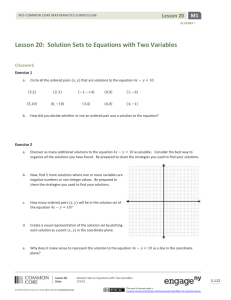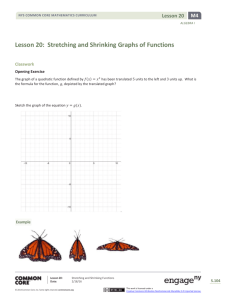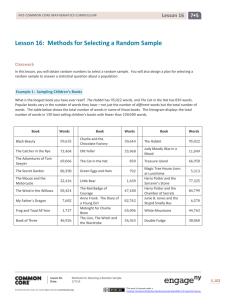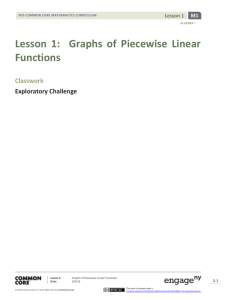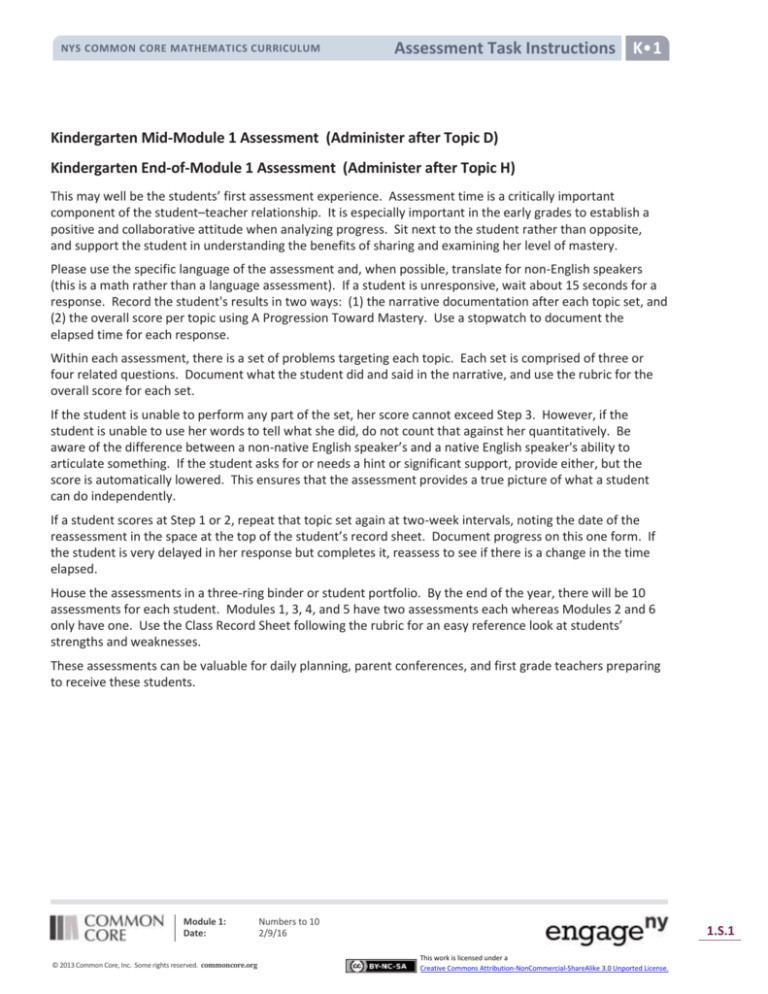
NYS COMMON CORE MATHEMATICS CURRICULUM
Assessment Task Instructions K•1
Kindergarten Mid-Module 1 Assessment (Administer after Topic D)
Kindergarten End-of-Module 1 Assessment (Administer after Topic H)
This may well be the students’ first assessment experience. Assessment time is a critically important
component of the student–teacher relationship. It is especially important in the early grades to establish a
positive and collaborative attitude when analyzing progress. Sit next to the student rather than opposite,
and support the student in understanding the benefits of sharing and examining her level of mastery.
Please use the specific language of the assessment and, when possible, translate for non-English speakers
(this is a math rather than a language assessment). If a student is unresponsive, wait about 15 seconds for a
response. Record the student's results in two ways: (1) the narrative documentation after each topic set, and
(2) the overall score per topic using A Progression Toward Mastery. Use a stopwatch to document the
elapsed time for each response.
Within each assessment, there is a set of problems targeting each topic. Each set is comprised of three or
four related questions. Document what the student did and said in the narrative, and use the rubric for the
overall score for each set.
If the student is unable to perform any part of the set, her score cannot exceed Step 3. However, if the
student is unable to use her words to tell what she did, do not count that against her quantitatively. Be
aware of the difference between a non-native English speaker’s and a native English speaker's ability to
articulate something. If the student asks for or needs a hint or significant support, provide either, but the
score is automatically lowered. This ensures that the assessment provides a true picture of what a student
can do independently.
If a student scores at Step 1 or 2, repeat that topic set again at two-week intervals, noting the date of the
reassessment in the space at the top of the student’s record sheet. Document progress on this one form. If
the student is very delayed in her response but completes it, reassess to see if there is a change in the time
elapsed.
House the assessments in a three-ring binder or student portfolio. By the end of the year, there will be 10
assessments for each student. Modules 1, 3, 4, and 5 have two assessments each whereas Modules 2 and 6
only have one. Use the Class Record Sheet following the rubric for an easy reference look at students’
strengths and weaknesses.
These assessments can be valuable for daily planning, parent conferences, and first grade teachers preparing
to receive these students.
Module 1:
Date:
© 2013 Common Core, Inc. Some rights reserved. commoncore.org
Numbers to 10
2/9/16
1.S.1
This work is licensed under a
Creative Commons Attribution-NonCommercial-ShareAlike 3.0 Unported License.
Mid-Module Assessment Task K•1
NYS COMMON CORE MATHEMATICS CURRICULUM
Date 1
Student Name _________________________
Topic A
Topic A: Attributes of Two Related Objects
Topic B
Rubric Score: ___________Time Elapsed ____________
Topic C
Date 2
Date 3
Topic D
Materials: (S) Module 1 Assessment Picture Cards, cut out
T:
T:
T:
T:
(Identify the pictures as you place them in a row before the student.) Show me the pictures that are
exactly the same.
How are they exactly the same?
Show me something that is the same but a little different.
Use your words, “They are the same, but…” to tell me how the bears are different.
What did the student do?
What did the student say?
Topic B: Classify to Make Categories and Count
Rubric Score: ___________Time Elapsed ____________
Materials: (S) Module 1 Assessment Picture Cards, cut out; sorting mat
T:
T:
(Place all of the cards before the student.) Please sort the pictures into two groups on your sorting
mat. (After sorting, have the student explain her reasoning.)
(Point to the objects that went in the backpack.) Count the things are in this group. (Look for the
answer “3” rather than “1, 2, 3.” If the student recounts to find the answer, ask again.)
Set the sort aside for the Topic D assessment.
Module 1:
Date:
© 2013 Common Core, Inc. Some rights reserved. commoncore.org
Numbers to 10
2/9/16
1.S.2
This work is licensed under a
Creative Commons Attribution-NonCommercial-ShareAlike 3.0 Unported License.
NYS COMMON CORE MATHEMATICS CURRICULUM
What did the student do?
Mid-Module Assessment Task K•1
What did the student say?
Topic C: Numerals to 5 with Different Configurations, Math Drawings, and Expressions
Rubric Score: ___________Time Elapsed ____________
Materials: (S) 10 linking cubes
T:
T:
T:
T:
(Put 5 un-connected cubes in front of the student.) Whisper count the cubes into a line. How many
cubes are there?
Move the cubes into a circle. How many cubes are there?
Scatter the cubes. How many cubes are there?
Please show this (show 2 + 1) using your cubes. (Have the student explain what she does. We might
expect the student to make a linker cube stick of 3 and break it into two parts.)
What did the student do?
Module 1:
Date:
© 2013 Common Core, Inc. Some rights reserved. commoncore.org
What did the student say?
Numbers to 10
2/9/16
1.S.3
This work is licensed under a
Creative Commons Attribution-NonCommercial-ShareAlike 3.0 Unported License.
Mid-Module Assessment Task K•1
NYS COMMON CORE MATHEMATICS CURRICULUM
!
!
!
!!
!
!
!
! 9#D! "#$%&'455&550 &1,'6+57' C !!( (
! 9#D! "#$%&'455&550 &1,'6+57' C !!( (
: ; . '<= ! ! = : '<= > ?'! 4 6@?! 4 68<. '<A> >8<ABA! '
: ; . '<= ! ! = : '<= > ?'! 4 6@?! 4 68<. '<A> >8<ABA!
'
!
!
X +*, "1(3(>$$1$$/ 1) -(I %<-, 21(! #2*$(
X +*, "1(3(>$$1$$/ 1) -(I %<-, 21(! #2*$(
Topic D: The Concept of Zero and Working with Numbers 0–5
!
!
!!
Rubric Score: ___________Time Elapsed ____________
(
(
(
(
!
!
!!
: ; . '<= ! ! = : '<= > ?'! 4 6@?! 4 68<. '<A> >8<ABA! '
!
! 9#D! "#$%&'455&550 &1,'6+57' C !!( (
(
(
X +*, "1(3(>$$1$$/ 1) -(I %<-, 21(! #2*$(
: ; . '<= ! ! = : '<= > ?'! 4 6@?! 4 68<. '<A> >8<ABA! '
!
! 9#D! "#$%&'455&550 &1,'6+57' C !!( (
X +*, "1(3(>$$1$$/ 1) -(I %<-, 21(! #2*$(
Materials: (S) Sort from Topic B (please remove one identical bear for this assessment task so that you have 5
toys and 3 school items), numeral writing sheet.
((
(
!
!
!!
!
!!
T:
T:
: ; . '<= ! ! = : '<= > ?'! 4 6@?! 4 68<. '<A> >8<ABA! '
!
!
!
!!
(
((
( (
! "#$$%&' (#) *(! +, ) -(. , / 012$(-+(34'
653S538(
!
!!
! "#$%&'( )'
* +,&)'
(
(
9 (6436(! +/ / +) (! +21:(;) <=(>""(2%?@-$(21$12A1*=(/"0 0 "1/"2&-"23(
(
(
: ; . '<= ! ! = : '<= > ?'! 4 6@?! 4 68<. '<A> >8<ABA! '
((
( -. -^'
(
X +*, "1(3(>$$1$$/ 1) -(I %<-, 21(! #2*$(
( -. -^'
( (
! "#$$%&' (#) *(! +, ) -(. , / 012$(-+(34'
653S538(
(
(
!
!
!
! "#$%&'( )'
* +,&)'
(
!
! 9#D! "#$%&'455&550 &1,'6+57' C !!( (
(
(
9 (6436(! +/ / +) (! +21:(;) <=( >""(2%?@-$(21$12A1*=(/"0 0 "1/"2&-"23(
(
(
(
!
!
(
(
(
(
( (
! "#$%&'( )'
* +,&)'
(
! "#$$%&' (#) *(! +, ) -(. , / 012$(-+(34'
653S538(
(
(
(
9 (6436(! +/ / +) (! +21:(;) <=( >""(2%?@-$(21$12A1*=(/"0 0 "1/"2&-"23(
(
(
(
( -. -^'
!
!
! "#$%&'( )'
* +,&)'
! "#$$%&' (#) *(! +, ) -(. , / 012$(-+(34'
653S538(
( -. -^'
9 (6436(! +/ / +) (! +21:(;) <=(>""(2%?@-$(21$12A1*=(/"0 0 "1/"2&-"23(
(
(
(
(
( (
(
((
(
(
(
(
!
!
!
!
What did the student do? Did the student show
evidence of subitizing or recognizing embedded
numbers, seeing 5 as 2 and 3 or 4 and 1?
(
(
! 9#D! " #$%&'455&550 &1,'6+57' C !!( (
(
T:
T:
T:
(
(
(
"#$%
&'455&550&1,'6+57'
&1,'6+57' C C!!(!!(( (
! 9!#D9!#D"! #$%
&'455&550
+*, "1(3(>$$1$$/
-(I 21(!
%<-, #2*$(
21(! #2*$(
X +*,X"1(3(>$$1$$/
1) -(I1)%<-,
How many things for school do you see? (Point to the top row.)
These are things we don’t usually bring to school. How many are in
this group? (Note if the student recounts all or determines the set
of 5 using the set of 3 in any way.) How did you know it was 5?
Write the number that tells how many toys there are.
How many cats are shown here?
Write your numbers in order from 0 to 4. (Note reversals, if any.)
X +*, "1(3(>$$1$$/ 1) -(I %<-, 21(! #2*$(
!
(
Note: Arrange the pictures as shown to the right. This arrangement is
intended to give the student the opportunity to see 5 as 3 and some more,
without recounting all.
!
( (
!
: ;!. '<=
'<= >4?'!
4 6@?!
68<. '<A>
>8<ABA!
: ; .!'<=
! =!: !'<== >: ?'!
6@?!
4 68<.4 '<A>
>8<ABA!
' !'
! &'("#$%
!&'"#$$%
&' (#)+,*(!
, / 012$(-+(34'
! " #$%
)' &'( )' ! "#$$%
(#) *(!
) -(.+, ,)/-(.012$(-+(34'
653S538(
* +,&)'* +,&)'
653S538(
( -.( -.-^'-^'
/ +)<=(!( +21:(;)
<=-$(21$12A1*=
(>""(2%?@-$(21$12A1*=
( /"0 0-"23(
"1/"2&-"23(
9 (6436(! 9+/(6436(!
/ +) (!+/
+21:(;)
>""(2%?@
( /"0 0 "1/"2&
What did the student say?
(
(
(
!
!
!
!
! "#$%&'( )'
* +, &)'
! "#$$%&' (#) *(! +, ) -(. , / 012$(-+(34'
653S538(
( -. -^'
! "#$%&'( )'
* +,&)'
! "#$$%&' (#) *(! +, ) -(. , / 012$(-+(34'
653S538(
9 (6436(! +/ / +) (! +21:(;) <=(>""(2%?@-$(21$12A1*=( /"0 0 "1/"2&-"23(
9 (6436(! +/ / +) (! +21:(;) <=( >""(2%?@-$(21$12A1*=(/"0 0 "1/"2&-"23(
Module 1:
Date:
© 2013 Common Core, Inc. Some rights reserved. commoncore.org
Numbers to 10
2/9/16
1.S.4
This work is licensed under a
Creative Commons Attribution-NonCommercial-ShareAlike 3.0 Unported License.
NYS COMMON CORE MATHEMATICS CURRICULUM
Mid-Module Assessment Task K•1
Mid-Module Assessment Task
Standards Addressed
Topics A–D
Know number names and the count sequence.
K.CC.3
Write numbers from 0 to 20. Represent a number of objects with a written numeral 0–20
(with 0 representing a count of no objects).
Count to tell the number of objects.
K.CC.4
K.CC.5
Understand the relationship between numbers and quantities; connect counting to
cardinality.
a.
When counting objects, say the number names in the standard order, pairing each
object with one and only one number name and each number name with one and
only one object.
b.
Understand that the last number name said tells the number of objects counted. The
number of objects is the same regardless of their arrangement or the order in which
they were counted.
Count to answer “how many?” questions about as many as 20 things arranged in a line, a
rectangular array, or a circle, or as many as 10 things in a scattered configuration; given a
number from 1–20, count out that many objects.
Understand addition as putting together and adding to, and understand subtraction as taking apart and
taking from.
K.OA.3
Decompose numbers less than or equal to 10 into pairs in more than one way, by using
objects or drawings, and record each decomposition by a drawing or equation (e.g., 5 = 2
+ 3 and 5 = 4 + 1).
Classify objects and count the number of objects in each category.
K.MD.3
Classify objects into given categories; count the numbers of objects in each category by
count. (Limit category counts to be less than or equal to 10.)
Evaluating Student Learning Outcomes
A Progression Toward Mastery is provided to describe and quantify steps that illuminate the gradually
increasing understandings that students develop on their way to proficiency. In this chart, this progress is
presented from left (Step 1) to right (Step 4). The learning goal for each student is to achieve Step 4 mastery.
These steps are meant to help teachers and students identify and celebrate what the student can do now,
and what they need to work on next.
Module 1:
Date:
© 2013 Common Core, Inc. Some rights reserved. commoncore.org
Numbers to 10
2/9/16
1.S.5
This work is licensed under a
Creative Commons Attribution-NonCommercial-ShareAlike 3.0 Unported License.
NYS COMMON CORE MATHEMATICS CURRICULUM
Mid-Module Assessment Task K•1
A Progression Toward Mastery
Assessment
Task Item
Topic A
K.MD.3
STEP 1
Little evidence of
reasoning without
a correct answer.
STEP 2
Evidence of some
reasoning without
a correct answer.
(1 Point)
(2 Points)
The student shows little
evidence of identifying
and/or explaining
similarities or
differences. Almost
non-responsive.
The student shows
evidence of beginning
to identify similarities
and differences, but is
unable to explain those
similarities or
differences using
words.
STEP 3
Evidence of some
reasoning with a
correct answer or
evidence of solid
reasoning with an
incorrect answer.
(3 Points)
STEP 4
Evidence of solid
reasoning with a
correct answer.
The student correctly
identifies both sets of
bears, but provides a
partial explanation of
how the bears are
similar or different.
The student correctly:
Or, the student can
explain the similarities
and differences, but
cannot identify one of
the sets of bears.
(ELLs may point to
express their insights
and gain a score of 3 if
you feel assured of
their understanding.)
Topic B
K.CC.4a
K.CC.4b
K.MD.3
The student shows little
evidence of
understanding how to
sort, or what
reasonable categories
might be.
The student is unable
to respond “3” or count
correctly.
The student shows a
beginning
understanding of how
to sort (with some
misplaced items), and
demonstrates early
explanation skills with
incomplete reasoning.
The student correctly
sorts the pictures into
two clearly distinct
categories, but cannot
provide a reasonable
explanation of the
categories or why the
items belong.
The students recounts
to answer “1,2,3.”
Or, the student
provides a reasonable
explanation of the
categories, but sorts
incorrectly.
The student is able to
answer “3” without
recounting.
Module 1:
Date:
© 2013 Common Core, Inc. Some rights reserved. commoncore.org
(4 Points)
Identifies the two
large bears as being
identical.
Identifies similarities
by attribute (size,
color, type, etc.).
Explains using words
how the two bears
differ either based
on size or
color/shade.
The student correctly:
Sorts the pictures
into two distinct
categories.
Provides a
reasonable
explanation outlining
the sorting
categories and why
the items belong
(i.e., things we keep
at home, things we
need to bring to
school).
The student is able
to answer ‘3’
without recounting.
Numbers to 10
2/9/16
1.S.6
This work is licensed under a
Creative Commons Attribution-NonCommercial-ShareAlike 3.0 Unported License.
NYS COMMON CORE MATHEMATICS CURRICULUM
Mid-Module Assessment Task K•1
A Progression Toward Mastery
Topic C
K.CC.4a
K.CC.4b
K.CC.5
K.OA.3
K.MD.3
The student shows little
evidence of
understanding how to
count objects in any
configuration, and is
unable to complete the
addition task.
The student shows
evidence of beginning
to understand counting
in a line, circle and
scattered
configurations, but is
unable to do so
accurately and
consistently. Student
recounts each time.
The student attempts
to add 2 + 1, but either
lacks an understanding
of how to add, or how
to interpret the
expression.
Topic D
K.CC.3
K.CC.4a
K.CC.4b
K.CC.5
The student shows little
evidence of
understanding how to
count items in a
category, and is
beginning to form some
numbers.
The student shows
evidence of beginning
to understand counting
items in a category, but
is unable to identify a
smaller quantity.
The student writes
some numerals
correctly, with
reversals.
The student arranges
and counts cubes in a
line, circle and
scattered configuration
correctly, responding
with “5” to each how
many question but
recounts once.
The student adds 2 + 1
but cannot explain how
to add; or the student
accurately explains the
process of addition, but
adds 2 + 1 incorrectly.
The student correctly
counts the items in
each category, but
cannot identify the
smaller group of items.
The student writes four
out of 5 numerals
correctly, with a
maximum of 1 reversal.
The student correctly:
Arranges and counts
5 cubes into a line,
circle, and scattered
configuration.
Answers “5” in
response to each
how many question
without recounting.
Breaks apart 3 to
show the
decomposition of 3
as 2 and 1 or 1 and
2.
The student correctly:
Identifies the
number of items in
each category
(counting all in the
toy category is
acceptable).
Identifies the group
of 3 as the smaller
group.
Writes numerals
0-4.
Module 1:
Date:
© 2013 Common Core, Inc. Some rights reserved. commoncore.org
Numbers to 10
2/9/16
1.S.7
This work is licensed under a
Creative Commons Attribution-NonCommercial-ShareAlike 3.0 Unported License.
NYS COMMON CORE MATHEMATICS CURRICULUM
Mid-Module Assessment Task K•1
Class Record Sheet of Rubric Scores: Module 1
Student
Names:
Topic A:
Topic B:
Topic C:
Topic D:
Attributes of Two
Related Objects
Classify to Make
Categories and
Count
Numerals to 5 in
Different
Configurations
Concept of Zero
and Working
with Numerals
0-5
Module 1:
Date:
© 2013 Common Core, Inc. Some rights reserved. commoncore.org
Next Steps:
Numbers to 10
2/9/16
1.S.8
This work is licensed under a
Creative Commons Attribution-NonCommercial-ShareAlike 3.0 Unported License.
NYS COMMON CORE MATHEMATICS CURRICULUM
Mid-Module Assessment Task K•1
Module 1 Assessment Picture Cards
Module 1:
Date:
© 2013 Common Core, Inc. Some rights reserved. commoncore.org
Numbers to 10
2/9/16
1.S.9
This work is licensed under a
Creative Commons Attribution-NonCommercial-ShareAlike 3.0 Unported License.
NYS COMMON CORE MATHEMATICS CURRICULUM
Mid-Module Assessment Task K•1
Sorting Mat
Module 1:
Date:
© 2013 Common Core, Inc. Some rights reserved. commoncore.org
Numbers to 10
2/9/16
1.S.10
This work is licensed under a
Creative Commons Attribution-NonCommercial-ShareAlike 3.0 Unported License.
NYS COMMON CORE MATHEMATICS CURRICULUM
Mid-Module Assessment Task K•1
Student Name __________________________
Numeral Writing
Module 1:
Date:
© 2013 Common Core, Inc. Some rights reserved. commoncore.org
Numbers to 10
2/9/16
1.S.11
This work is licensed under a
Creative Commons Attribution-NonCommercial-ShareAlike 3.0 Unported License.




